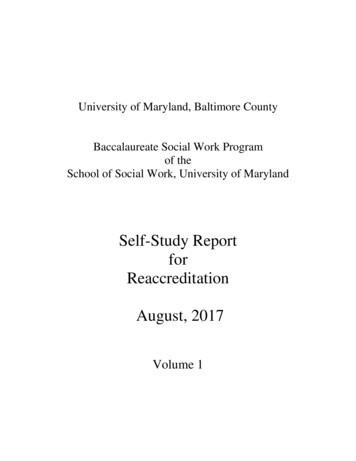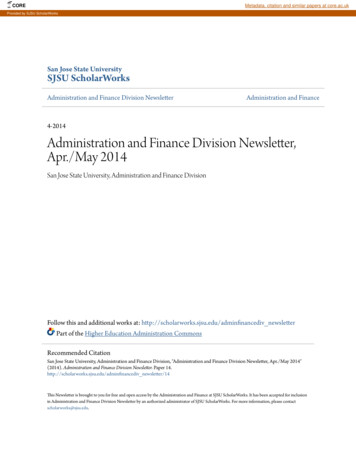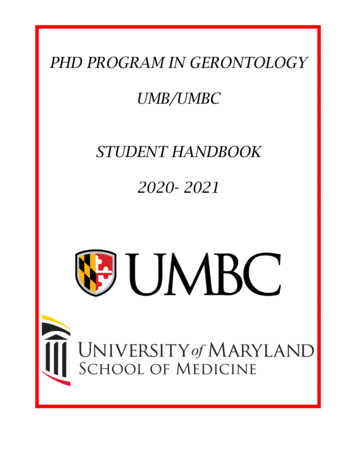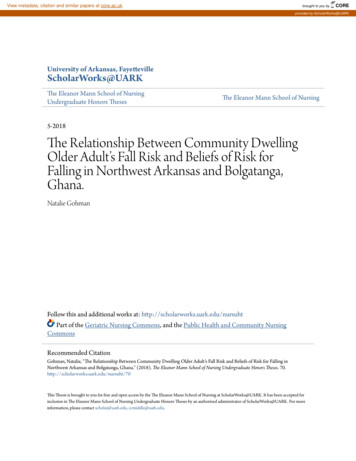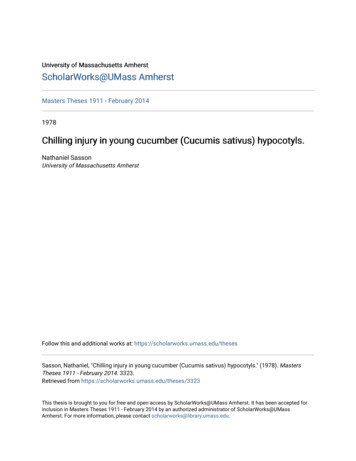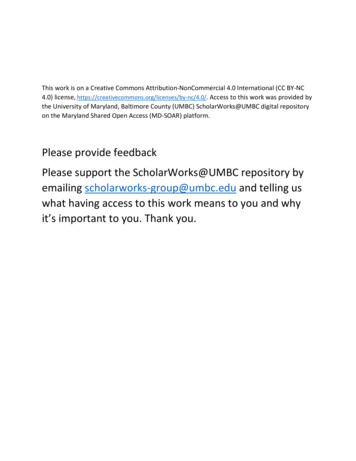
Transcription
This work is on a Creative Commons Attribution-NonCommercial 4.0 International (CC BY-NC4.0) license, https://creativecommons.org/licenses/by-nc/4.0/. Access to this work was provided bythe University of Maryland, Baltimore County (UMBC) ScholarWorks@UMBC digital repositoryon the Maryland Shared Open Access (MD-SOAR) platform.Please provide feedbackPlease support the ScholarWorks@UMBC repository byemailing scholarworks-group@umbc.edu and telling uswhat having access to this work means to you and whyit’s important to you. Thank you.
Prevalence and Functional Consequences of Social Anxiety in Individuals at Clinical High-Risk forPsychosis: Perspective from a Community Sample ComparisonuscripVijay A. Mittal2,3,8-10tCharlotte Chun5, Lauren M. Ellman5, Jason Schiffman6,7, &1Department of Psychology, University of Illinois at Chicago, Chicago, IL, USA2Department of Psychology, Northwestern University, Evanston, IL, USA3anInstitute for Innovations in Developmental Sciences (DevSci), Northwestern University, Evanstonand Chicago, IL, USA4University of North Carolina at Chapel Hill, Department of Psychiatry, Chapel Hill, NC, USADepartment of Psychology, University of Maryland Baltimore County, Baltimore, MD USADepartment of Psychology, University of California at Irvine, Irvine, CA USA8d7Department of Psychiatry, Northwestern University, Chicago, IL USA9pte6Department of Psychology, Temple University, Philadelphia, PA, USAM5Medical Social Sciences, Northwestern University, Chicago, IL, USAInstitute for Policy Research (IPR), Northwestern University, Chicago, IL, USAAcce10 The Author(s) 2021. Published by Oxford University Press on behalf of the University ofMaryland's school of medicine, Maryland Psychiatric Research Center.This is an Open Access article distributed under the terms of the Creative CommonsAttribution-NonCommercial License (http://creativecommons.org/licenses/by-nc/4.0/), whichpermits non-commercial re-use, distribution, and reproduction in any medium, provided theoriginal work is properly cited. For commercial re-use, please contactjournals.permissions@oup.comDownloaded from icle/doi/10.1093/schizbullopen/sgab025/6309969 by guest on 07 July 2021Franchesca S. Kuhney1, Katherine S. F. Damme2,3, Andrea Pelletier-Baldelli4,
Corresponding Author:Franchesca S. KuhneyUniversity of Illinois at Chicagouscript1007 W. Harrison St.Chicago, IL 60607Tel: 301-452-7056AcceptedManEmail: fkuhne2@uic.eduDownloaded from icle/doi/10.1093/schizbullopen/sgab025/6309969 by guest on 07 July 2021Department of Psychology
AbstractBackground: Social anxiety disorder (SAD) commonly occurs among individuals at clinical high-risk(CHR) for psychosis. Extant research has yet to examine the prevalence and clinical/functionalmay improve the generalizability that traditional non-psychiatric control samples cannot provide.tAdditionally, it remains unknown how SAD contributes to symptom severity and social impairmentsuscripin individuals at CHR for psychosis.Methods: Both CHR and CC groups were recruited from general community sources; CC participantswere not excluded in this analysis on the basis of any psychopathology except psychosis. A total of245 adolescents and young adults (CHR 81; CC 164) were administered the Social Phobia Scalean(SPS), the Structured Interview for Psychosis-risk Syndromes (SIPS), Structured Clinical Interview forMDSM-5 Research Version (SCID-5-RV), and the Social Functioning Scale (SFS).Results: The CHR group was at increased risk for having SAD relative to CC (42% CHR;d13% CC; RR 3.28) and, to a lesser degree, a non-SAD anxiety disorder (41% CHR; 29%pteCC; RR 1.42). Greater social anxiety was related to higher levels of negative (r 0.29) butnot positive (r 0.05) symptoms within the CHR group. Furthermore, elevated social anxietycewas found to be linked with poor social functioning in the CHR group (r -0.31).AcConclusions: These findings demonstrate the specificity of SAD over and above other anxietydisorders in individuals at CHR for psychosis and the critical target of SAD to treat subclinicalpsychotic symptoms and social functioning.Keywords: psychosis-risk; prodrome; social anxiety; social functioningDownloaded from icle/doi/10.1093/schizbullopen/sgab025/6309969 by guest on 07 July 2021correlates of SAD in this population compared to a community control (CC) sample. This comparison
1. IntroductionAnxiety disorders are among the most common comorbid diagnoses in individualswith psychotic disorders1,2. Among anxiety-related disorders, social anxiety, specifically, ispositive (e.g., paranoia, persecutory ideation) and negative (e.g., anhedonia, alogia, bluntedtexpression of emotion) psychotic symptoms6. In psychosis, social anxiety has importantuscripcontributions to reduced quality of life4, social function4,7,8, and self-esteem9. Social anxietymay also contribute to impairments in social support and quality of social relationshipsassociated with worsening course and recurrence of psychotic episodes10. This relationship toclinical course may be particularly important for those at clinical-high risk for psychosisan(CHR), who also experience elevated levels of anxiety disorders that lead them to seektreatment11. Additionally, social anxiety may relate to risk for psychosis (attenuatedMpsychosis symptoms) and social functioning in CHR individuals. The prevalence and clinicalpteand treatment targets12.dimpact of social anxiety may have implications for first psychosis onset, functional outcomes,The potential influence of anxiety disorders can often be overlooked in clinicalceresearch, despite estimates of anxiety disorders in CHR individuals being high (14%53%)13,14,15,16,17,18. However, extant research does not provide a clear comparison ofAcprevalence rates between CHR individuals and their community peers. Instead, most extantliterature compares CHR samples to non-help-seeking controls who do not endorse majorpsychiatric illness16,19. By nature, this approach selects a comparison group that does notnecessarily represent the general population. The few studies that have compared the rates ofanxiety in help-seeking CHR individuals16,18 found social anxiety to be the most prevalent.As a result, questions remain regarding the generalizability and specificity of inferences thatcan be made about the comorbidity of social anxiety with CHR for psychosis20. Non-Downloaded from icle/doi/10.1093/schizbullopen/sgab025/6309969 by guest on 07 July 2021highly prevalent among individuals with psychosis2,3,4,5 and is reflected in aspects of both
psychiatric samples inflate the effect of the independent variables, complicating theinterpretation of study findings21. Extant studies focused on the prevalence of social anxietydisorder may overestimate the magnitude of the difference between groups.psychotic symptoms in CHR individuals16,18 have found conflicting results, similar to studiesexamining this relationship in psychosis9,22,23. One study demonstrated a unique relationshipuscriptbetween social anxiety and positive symptoms in CHR individuals16; the other found that socialanxiety symptoms were related to both positive symptoms and negative symptoms18. Thus, socialanxiety appears related to symptom severity, but the specificity of that relationship to positive ornegative symptom domains remains unclear. As a result, questions remain regarding how comorbidansocial anxiety may relate to symptom severity and course in those at CHR for psychosis.Further, addressing social anxiety may attenuate social dysfunction in CHR individuals andMpotentially reduce risk for worsening course24,10. Despite a paucity of research investigating socialanxiety in the psychosis-risk syndrome, a number of studies have identified the critical role of socialptedfunctioning and social support in clinical course in individuals at CHR for psychosis. People at CHR forpsychosis exhibit impairments in social functioning25, deficits in the number, and quality of closerelationships, which leads to lower quality of life26. Early impaired social functioning and quality ofcelife in CHR individuals appears to be a core feature of risk for psychosis24, 26,27,28,29,30,31, and may beAcrelated to the presence of comorbid anxiety disorders32,33. Yet, the particular role of social anxiety tothese interpersonal functioning deficits is unknown, though social anxiety may contribute to reducedsocial function.The current study examined the prevalence of social anxiety and other anxiety disorders in acommunity sample of CHR young adults and community control (CC) sample. This CC comparisongroup includes individuals with a range of psychopathology. We hypothesized that the CHR groupwould be at greater risk for having a social anxiety disorder diagnosis and elevated social anxietyDownloaded from icle/doi/10.1093/schizbullopen/sgab025/6309969 by guest on 07 July 2021The few studies that have examined the relationship between social anxiety and attenuated
symptoms compared to the CC group. We predicted that CHR status would be specifically related tosocial anxiety and not reflect a general increased risk for anxiety disorders. Next, in an effort tobetter understand how social anxiety is related to other core components of the CHR syndrome, thesymptom domains in the CHR group. Based on conflicting conclusions of previous studies16,18, ouranalysis was exploratory. Finally, the current study examined the association between social anxietyuscriptand social functioning, specifically within a sample of CHR young adults, which may have clinicalimplications for the targeted treatment of social anxiety to improve functional impairments. Wepredicted that increased social anxiety symptoms among the CHR group would relate to decreasedsocial functioning.an2. MethodsM2.1. ParticipantsParticipants included adolescents and young adults who were recruited as part of thedongoing Multisite Assessment of Psychosis-Risk34 (MAP; 2017-2020 for current analytic sample)ptestudy. The MAP study is a large investigation of early identification and evaluation of psychosis-riskwithin the community. Participants were recruited through various outlets, including Craigslist posts,ceonline ads (e.g., through Facebook), online student volunteer pools, a refer-a-friend link, andhanging flyers in public locations across the catchment areas: the greater Philadelphia, Chicago, andAcBaltimore areas. In concordance with the study goals of assessing psychosis risk in a non-treatmentseeking, community comparison group, clinical locations such as outpatient clinics and hospitalswere not targeted for recruitment. Inclusion criteria for the MAP study also required that allparticipants were proficient in English, ages 16-30, and had normal or corrected vision. Although thepresence of a past or current psychotic diagnosis (n 3; assessed at in-person visit) was not anexclusion criterion, those with psychotic diagnoses were excluded from the current analyses.Downloaded from icle/doi/10.1093/schizbullopen/sgab025/6309969 by guest on 07 July 2021current study examined the relationship of social anxiety symptom severity to positive and negative
Participant selection contained two phases: first, participants (n 3,460) completed an onlinesurvey that included a battery of questionnaires, among which were two self-report scales ofpsychosis-risk: the Prodromal Questionnaire35 (PQ; psychosis-risk threshold reporting 8 distressingthreshold endorsing reporting two ratings of 5s or one rating of 6). Second, eligibility to participatein Phase 2 was determined by being either above the predetermined psychosis-risk thresholduscript(Questionnaire High Risk; n 651) or randomly selected from participants below the threshold(Questionnaire Low Risk; n 656). There were no other exclusion criteria. Finally, eligible participantswere invited for in-person clinical interviews. At the time of the current analysis, 539 participantshad completed interviewers or were in progress. The analytic dataset included 245 participants thatanhad data available for variables of interest (e.g., Social Functioning Scale, Social Phobia Scale, SIPSpositive and negative scores, complete Structured Clinical Interview for DSM-5). All raters wereMadvanced research assistants, doctoral student in clinical psychology, and postdoctoral fellows. Toensure accurate and consistent diagnoses across the study sites the following procedures weredfollowed: (1) all clinical interviewers were SIPS certified at an official SIPS training (2) diagnosticpteconsensus phone meetings (with one senior rater from each site) were held to review interviewswith clinical symptoms (3) if there were disagreements in consensus calls, cases were triaged to thecePI meeting and the 3 PIs resolved disagreements (majority rule)34.Ac2.2. Clinical MeasuresDuring the MAP study Phase 1, the Social Phobia Scale37 (SPS) and the Social FunctioningScale38 (SFS) were administered online. The SPS is a 20-item self-report measure with questionspertaining to anxiety related to scrutiny and being observed by others. Each item is rated on howaccurately the question characterizes the respondent on a scale of 0 (not at all) to 4 (extremely). TheSPS is a reliable and valid measure of social anxiety symptoms39. The SFS is a 79-item self-reportmeasure designed to assess social functioning in schizophrenia. Items rate ability and performanceDownloaded from icle/doi/10.1093/schizbullopen/sgab025/6309969 by guest on 07 July 2021items on the positive symptom subscale) and the PRIME Screen36 (psychosis risk
related to social engagement, interpersonal contact, recreation, independence and competence inactivities, and activities of daily living and employment38. The SFS is a well-established measurewithin psychosis literature, demonstrates strong internal reliability and consistency, and is aMAP study modified it to reflect impairments of the target adolescent/young adult demographic.Modifications consisted of excluding subscales assessing ability and performance of skills necessaryuscriptfor independent living (independence-competence and independence-performance subscales).Additionally, the occupation/employment subscale of the SFS may not be an appropriate scale formost high school or college-age samples and was adjusted to fit the adolescent/young adult sample.Subsequently, the scoring of this occupation/employment subscale was adapted to account foranthese changes. A higher total SFS score indicates better social functioning.Phase 2 of the MAP study consisted of in-person interviews. Among these interviews, theMStructured Interview for Psychosis-Risk Syndromes40 (SIPS) and the Structured Clinical Interview forDSM-5, Research Version41 (SCID-5-RV) were used. The current study focused on the CHR groupptedconsisted of individuals meeting SIPS criteria for attenuated positive symptoms syndrome (APSS).This inclusion criteria included those identified as APSS persistent (CHR persistent; n 44; symptomseverity and frequency have remained stable over the past 12 months) or APSS progressive (CHRceprogressive; n 37; attenuated symptoms have begun or worsened in severity and frequency withinActhe past year). A chi-square analysis determined that there was no significant difference in theprevalence of social anxiety disorder diagnosis between these subgroups, 2 1.8, p 0.18, and thecategorical analyses in this study combined these subgroups into one single CHR group. The SIPSrates positive symptom severity on a 7-point Likert-type scale rated absent (0) to psychotic (6). Forthe current study, sum scores were used to quantify positive and negative symptoms. Participants atPhase 2 that did not meet the criteria for a CHR syndrome were considered part of the CC group(n 164). The SCID-5-RV is a semi-structured interview used to assess the presence of major DSM-5mental diagnoses41. The SCID-5-RV has demonstrated moderate-to-strong reliability and is currentlyDownloaded from icle/doi/10.1093/schizbullopen/sgab025/6309969 by guest on 07 July 2021sensitive measure of social functioning38. The SFS is a measure designed for adults, and as such, the
considered the “gold standard” of clinical diagnostic assessment. The study used the SCID-5-RV toassess the presence of a current diagnosis of social anxiety disorder (SAD).2.3. Statistical Approachsquare tests of independence were used to examine differences in age and gender betweentexperimental groups. Chi-square tests were used to examine group differences in the prevalence ofuscripSAD diagnosis, other anxiety disorder diagnoses, and no anxiety-related diagnosis. Individuals with aSAD diagnosis only, as well as individuals with a SAD diagnosis and comorbid disorders, wereincluded in the “SAD category”. The “other anxiety-related disorder” category included multipleanxiety-related diagnoses (i.e., generalized anxiety disorder, specific phobia, agoraphobia, panicandisorder). The low frequency of each of these anxiety disorders warranted combining them into oneMgroup to most conservatively estimate the difference between other anxiety-related disorders andsocial anxiety in CHR and CC groups. Consistent with the rationale for a community sampledcomparison group, the “no anxiety-related diagnosis” category is not an artificially “clean” category,ptebut rather identifies those who do not have any DSM-5 anxiety disorder, though these individualsmay still have another non-anxiety diagnosis (see Supplemental Table 1). A follow-up examination ofcethe standardized residuals (i.e., normalized residuals of the observed and expected frequencies inthe omnibus chi-square test) was conducted to identify cells that significantly contributed to the chi-Acsquare value. In the current study, a large standardized residual ( 2) indicated that more or lessparticipants than expected by chance were part of a cell, and thus, significantly contributed to theomnibus chi-square result43. Additionally, follow-up relative risk ratios44,45 were calculated46 (epiR).Relative risk ratios provide estimates of the likelihood of an outcome (SAD, other anxiety-relateddisorder, no anxiety-related disorder) for an exposed group (CHR) relative to the likelihood of theoutcome in the control group44,45(CC). Separate linear regression models42 were employed in twoseparate analyses to investigate the relationship between social anxiety symptom levels and positiveDownloaded from icle/doi/10.1093/schizbullopen/sgab025/6309969 by guest on 07 July 2021All analyses were estimated using R version 3.6.142. Independent samples t-tests and chi-
and negative symptoms (lm base function). Next, to examine the relationship between social anxietysymptom severity and social functioning within the CHR group, linear models were used to examinethe association between SAD symptom level and social functioning. Continuous social anxietyrelation to positive and negative symptoms and social functioning. In evaluating the pattern ofmissing data, the finalfit47 R packages were used. There were minimal missing data for the variablesuscriptof interest (SAD diagnosis n 0; SPS total n 9; SIPS positive symptoms total n 1; SIPS negativesymptoms total n 19, SFS total n 14). Missing data were assessed for bias but were found to bemissing completely at random, following no trends by group, sex, or age, as assessed bymissing pairs and missing compare R functions.M3.1. Demographics of the CHR and CC samplesan3. ResultsThere were no significant differences between CHR (n 81) and CC (n 164) groups fordgender, 2(1) 0.44, p 0.50, age, t(137.51) 1.52, p 0.13, race, 2(5) 5.19, p 0.39, or householdpteincome, 2(17) 19.76, p 0.29. See Table 1 for demographic information and Supplemental Table 2for household income, years of education completed, and current role information. Within the CHRcegroup, there was no significant difference in age, t(137.51) 1.52, p 0.13, nor gender, 2 0.44,Acp 0.50, between CHR persistent and CHR progressive subgroups.3.2.1. Group differences in the prevalence of social anxiety and other anxiety diagnosesThe prevalence of SAD diagnosis, other anxiety-related diagnoses, and no anxiety-relateddiagnoses were compared across CHR and CC groups using a 3x2 chi-square analysis. There was asignificant difference in the prevalence SAD, other anxiety-related diagnoses, and no anxiety-relateddiagnoses between CHR and CC groups, 2(2) 43.52, p 0.001 (Figure 1). Follow-up examination ofthe standardized residuals from the omnibus chi-square showed that significantly fewer participantsDownloaded from icle/doi/10.1093/schizbullopen/sgab025/6309969 by guest on 07 July 2021symptom severity was used in this analysis. Relatedly, categorical diagnosis was also examined in
in the CHR group than expected by chance had no anxiety-related diagnosis (Std. Residual -2.9,p 0.004), and significantly more than expected by chance had a SAD diagnosis (Std. Residual 3.7,p 0.001). In contrast, significantly more CC participants than expected by chance had no anxiety-SAD diagnosis (Std. Residual -2.6, p 0.009). Follow-up risk ratios demonstrated that the CHR group,relative to CC, had an increased risk of having SAD by approximately 3-fold (RR 3.30, 95% CI: 2.04 –uscript5.27, OR 4.93). Additionally, the risk of having no anxiety-related diagnosis was 0.30 times less inthe CHR group relative to CC (RR 0.29, 95% CI: 0.18 – 0.48, OR 0.15). Furthermore, the CHR grouphad approximately 1.4 times greater risk compared to the CC group (RR 1.42, 95% CI: 1.00 – 2.03,OR 1.71) of having another, non-SAD anxiety disorder. Supplemental Table 1 provides the frequencyanof other anxiety-related disorders and no-anxiety related diagnostic groups across CHR and CCgroups. The increased risk of SAD in the CHR group, which was even greater than the relative risk ofMhaving another anxiety-related diagnosis, further supports subsequent analyses solely examiningSAD’s relationship to subclinical psychotic symptoms and social function. Chi-square analyses weredalso conducted excluding individuals with comorbid diagnoses and including these individuals asptetheir own group, and both demonstrated significant differences in base rates across CHR and CCgroups (see Supplemental Materials [SM]).ce3.2.2. Group differences in levels of social anxiety symptomsAcSocial anxiety symptoms were compared across CHR and CC groups in an independentsample t-test. CHR and CC groups differed in self-reported social anxiety, such that the CHR groupexhibited increased symptoms of social anxiety (M 31.70, SEM 2.07) compared to the CC group(M 20.50, SEM 1.30), t(234) 4.71, p 0.001, d 0.63.Downloaded from icle/doi/10.1093/schizbullopen/sgab025/6309969 by guest on 07 July 2021related diagnosis (Std. Residual 4.6, p 0.001) and significantly fewer than expected by chance had a
3.3. Relationship between social anxiety to positive and negative symptom severityTwo separate linear regression analyses examined the relationship of social anxietysymptoms to positive and negative symptoms in the CHR group, Figure 2. Greater negativeSPS score) among CHR participants, b 1.05, t(57) 2.28, r 0.29, r2 0.07, p 0.03. Total positivetsymptoms score was not significantly related to the total SPS score, b 0.28, t(74) 0.43, r 0.05, r2 -uscrip0.01, p 0.67, among the CHR group. Supplemental analyses examined this question with categoricaldiagnoses, and individuals who met DSM criteria for comorbid SAD had greater positive, but notnegative, symptoms compared to those who did not (SM).an3.4. Functional outcomes of social anxietyTo investigate the relationship between social anxiety and social functioning in the CHRMgroup, linear modeling was employed. Social anxiety symptoms were negatively correlated withsocial functioning, b -0.25, t(69) -2.71, r -0.31, r2 0.08, p 0.008, demonstrating that increaseddsymptoms of social anxiety were associated with decreased social functioning in the CHR group.pteAdditionally, a supplemental analysis found that the CHR group had significantly lower socialfunctioning compared to the CC group (SM). Related supplemental analysis also examined socialcefunctioning by categorical diagnoses within the CHR group only and found no significant differenceAcbetween individuals in the CHR group by SAD diagnosis of SAD (SM).Downloaded from icle/doi/10.1093/schizbullopen/sgab025/6309969 by guest on 07 July 2021symptoms (total negative symptoms score) were related to greater social anxiety symptoms (total
4. DiscussionIndividuals at CHR for psychosis showed approximately 3 times greater risk of having a SADdiagnosis relative to a heterogenous CC sample and showed a specific vulnerability to SAD. While theto the CC group, the risk of having a non-SAD anxiety diagnosis was approximately half of thetrelative risk of having a SAD diagnosis. Furthermore, the severity of social anxiety symptoms wasuscriprelated to both increased severity of negative symptoms and reduced social functioning among CHRindividuals. Interestingly, social anxiety symptoms related to negative and not positive symptoms.These results suggest that social anxiety is prevalent in people that meet criteria for a CHR syndromeand may be an important area of further study to address social difficulties and negative symptomsanin those in the psychosis risk period. Collectively, these findings provide insight into the scope ofsocial anxiety and its clinical and functional importance among CHR individuals, in particular, whenMcompared to their peers in the general population.dIndividuals at CHR for psychosis are at greater risk of having a comorbid SAD relative to theirpteCC peers. Indeed, the relative risk of having comorbid SAD was greater than the risk of havinganother anxiety-related disorder in CHR individuals compared to their CC counterparts. Findings ofcethe current study provide new evidence that SAD may be more common than other anxietydisorders in CHR individuals. Consistent with previous studies13,14,15,17, approximately 42% of the CHRAcgroup met criteria for comorbid social anxiety disorder; matching an estimate from a previousstudy16 exactly. By using a general community sample, the current study advances previous findingsthat CHR populations have an increased prevalence of social anxiety compared to their peers in twoways. First, the use of a general community sample reduces the bias in a traditionally non-psychiatricsample toward lower rates of social anxiety disorder20,21. Second, as it is unlikely that weunderestimated the rates of social anxiety in our control participants, we can be confident that theCHR group has a 3-fold greater risk of having social anxiety compared to community peers. ThisDownloaded from icle/doi/10.1093/schizbullopen/sgab025/6309969 by guest on 07 July 2021CHR group demonstrated increased risk for both SAD and other anxiety-related diagnoses compared
difference in prevalence suggests that social anxiety may be a critical area for future research tofocus on the contribution of social anxiety to mechanisms of psychosis, treatment, and outcome.Within the CHR group, social anxiety was also related to symptom severity for negative butsocial anxiety symptoms were related to negative symptoms. Additionally, work by Mazeh et al.6tdemonstrated that avoidant cognitions within social anxiety were specifically associated withuscripnegative symptoms in patients with schizophrenia. However, it is also possible that social anxietycontributes to secondary negative symptoms in a primary/secondary negative symptom theoreticalframework48,49. This theory postulates that negative symptoms are considered primary if they are adirect result of psychosis but are considered secondary if they are driven by other mechanisms, suchanas social anxiety49. For example, negative symptoms in CHR individuals, such as asociality, could bedue to social anxiety and not a result of CHR syndromes. The current study provides support for theMpotential for social anxiety to be a treatment target for future investigation to improve negativesymptom severity. To further clarify our understanding here, future studies should examine specificptedfeatures of social anxiety (e.g., avoidance and fear6) as well. In addition to symptoms, social anxietywas related to deficits in social function among those at CHR for psychosis. This finding wasconsistent with established results from previous literature that social anxiety and social functioningceimpairments were present in patients with a psychosis spectrum diagnosis22,50 and in CHRAcindividuals27.In a supplemental analysis, social functioning did not differ among CHR individuals with andwithout a comorbid SAD diagnosis. This categorical approach revealed a great deal of heterogeneityin social anxiety symptoms and social functioning by diagnosis, which masked a relationshipbetween social anxiety symptoms and social functioning that were apparent when social anxietysymptoms were examined dimensionally (SM Figure 1). Parallel supplemental analyses revealed thatpositive, but not negative, symptoms were greater in CHR individuals with a comorbid diagnosis ofDownloaded from icle/doi/10.1093/schizbullopen/sgab025/6309969 by guest on 07 July 2021not positive symptoms. This finding is consistent with results by McAusland et
advanced research assistants, doctoral student in clinical psychology, and postdoctoral fellows. To ensure accurate and consistent diagnoses across the study sites the following procedures were followed: (1) all clinical interviewers were SIPS certified at an official SIPS training (2) diagnostic .


